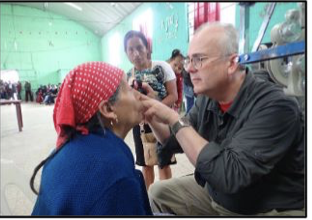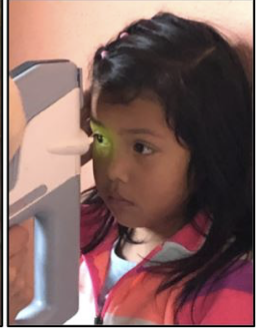
During their Guatemala Eye Project in early January, members of the Rotary Club of Edmonton West experienced a mix of emotions.

“During any international projects, there are those moments when you see instantly the difference you are making to the lives of the people you are helping,” says club president Annie Mueller. “There are also the heartbreaking moments when you realize there is nothing you can do.”
A high point of the mission for Annie was the reaction of a patient after receiving reading glasses. “He was so happy and grateful that he went around to all of the volunteers to thank them personally. These glasses will change his life.”
For others who came to clinics seeking help, there was disappointment.
“A mother brought in her son, who had very poor sight. She was full of hope that we could help. Unfortunately, (ophthalmologist Carlos Solórzano) had to tell her that nothing could be done and her son would lose his sight completely,” Annie says. “He will not be able to finish school, work or lead a productive life.”
Dr. Solórzano is a member of the Rotary Club of Huehuetenango, which runs the project annually. The Guatemalan team included optometrists, two ophthalmology residents, a dentist, a pediatrician several Rotary volunteers.

“They pick the clinic locations, ensuring that they are the most needy and have the facilities we need,” says Edmonton optometrist and Rotarian Benjamin Doz, who led the team from Edmonton West. “They handle the advertising, translators, volunteers and transportation. In addition, they arrange billets and ensure the visiting teams are kept healthy and safe.”
“They are some of the warmest, most hospitable Rotarians you will ever run into,” Benjamin says. “Their skills and abilities married up with efficiency are what have made this project so successful over 22 years.”
Benjamin and his wife Marley have been involved in this project for all those years. Other Rotarians from Edmonton West who were part of the Edmonton contingent are Al and Karen Sanderson, Duane and Cathy Evans, Fred Kraft and Lorne Proctor. The Rotarians were trained to support the work of the optometrist and ophthalmologists.
“They performed triage, pre-testing, pharmaceutical dispensing, glasses dispensing and physician assistance,” Benjamin says. “Everyone worked in organization, basic labour and patient care.”

A total of 841 patients were seen in clinics held in three communities during the week-long mission.
“We dispensed medication, gave out reading glasses, ordered prescription glasses to be sent from Canada and booked 44 cataract surgeries,” Annie says.
The mission wasn’t without challenges, beginning as soon as the Canadians landed in Guatemala City.
“Upon arriving in Guatemala City, we learned that our medical equipment hadn’t arrived. It was still in Mexico,” Annie says.
“The next morning, Ben and Lorne stayed behind to sort out the lost luggage and the rest of the team proceed to Antigua (a town about 45 minutes from Guatemala City),” she says. “We set up a clinic in a school for orphans and children of single mothers, which the Rotary Club of Canmore helps to fund.”
During this clinic, the team saw 67 children and adults who suffered from various conditions. “We dispensed medication, handed out reading glasses and took orders for prescription glasses,” Annie says.
The next morning, the team traveled to La Libertad, where they held clinics for three days.
“This village is very isolated and situated on the side of a mountain at an elevation of 5,643 feet,” Annie says. “The roads were incredibly steep. It took a lot of skill to get the van and truck to the clinic, which of course, was at the highest point in the village.”
At the end of the first day of this clinic, the team headed to its hotel, which Annie describes as “unfinished—some rooms had no running water, no bedding or working toilets.”
“In each room, a two-foot metal cage was fixed some six feet up on a wall opposite the bed. Likely it was to lock a TV into, but it was empty,” Benjamin says.
With several roosters crowing outside their rooms, “we decided that [these cages] would be a great place to keep your rooster,” Annie says.

After three days in La Liberta, the team returned to Huehuetenago, where they attended
a Rotary meeting and spent the night, before heading to the small town of Casa Grande for the final two days of clinics.
“It was a miserable four-plus hour drive from Huehuetenago, across a 10,000-foot plateau,” Benjamin says. The clinic was set up in the community centre.
During this clinic, the team was joined by a pediatrician, who is a member of the Huehuetenago Rotary Club.
“The pediatrician was quite a guy,” Benjamin says. “He motorcycled into Casa Grande through the rain. He worked a very long day and then went home in the rain in the dark that night.
“He asked what he could do at the start of the day. Being short of translators who could do an apt job, I thought [of] counselling noncompliant diabetic patients and doing informed consents for surgery would help with a small backlog of patients we had at the time.
“I thought it was a small, short task. Little did I know how much diabetic retinopathy would be seen and how much surgery was required. He was surrounded with a lineup of patients for the rest of the day—likely far more than anyone would want to do looking forward to that drive home.”
Summing up her experience as part of the Guatemala Eye Project, Annie says:
“Guatemala is bright, energetic and colourful. We saw mountains, isolated plateaus and powerful volcanoes. But the people are what make Guatemala such a special place. They are friendly, helpful and they welcomed us with open arms. Many of the patients we saw were quick to smile and laugh. It was a pleasure to spend time with them.”
She has particular praise for the two young men who served as translators and provided an example of how they made the team’s jobs so much easier.
“Fred was fitting glasses for a lady. He had given her the prescription indicated by Ben on her card, and was asking her, through the interpreter, if she could read what was on the card. She said ‘No.’ He double-checked the prescription, gave her a different pair of glasses and tried again. She said ‘No.’ Fred went back to ask Ben if he was misreading the prescription. No, Ben assured him that it was correct. Fred then went back to the lady and tried again. No luck. It was then that Fred realized, through the interpreter that the glasses were perfect. She just couldn’t read!”